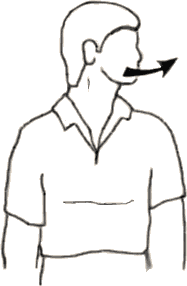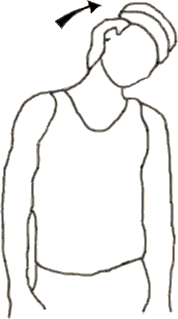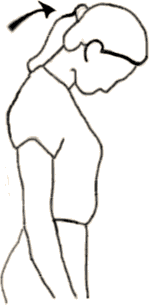Posts Tagged ‘color’
 The learning brain needs “uprightness” for greatest efficiency
The learning brain needs “uprightness” for greatest efficiency
Human neurology thrives on color, movement, gentle music, and “uprightness” for the most efficient learning
The learning brain needs “uprightness,” in addition to color, movement and gentle music (discussed in my previous article, June 12, 2010). If you wish to review that previous article, just click on the title below:
A learning brain learns best with color, movement, and gentle music

What is meant by “uprightness” for most learning efficiency?
The ideal of “uprightness” occurs when the student is at a blackboard (greenboard).
The brain is so constructed neurologically that it is most efficient when the material to be learned is “above the noseline,” so to speak, as in the photograph above.
In other words, the best brain “registration” for memory occurs when the material to be learned is located above a line straight out from the students nose.
Why is “above the noseline” best?
We are not sure why. It seems that human neurology is arranged vertically, somewhat analogously to a vertical four-drawer filing cabinet.
(1) The top drawer registers and files visual material, the pictures we see with our eyes.
(2) The second drawer down registers and files auditory material, the things we hear with our ears.
(3) The third drawer down registers and files haptic material, the tactile sensations we encounter with our hands, and the rest of our body. It also includes the proprioceptive system, the internal sensations of the muscles, joints, tendons, and inner ear, that accompany body movement.
(4) The bottom drawer registers and files affective material, the emotions we feel in our “heart,” or “gut,” if you like.
Thus, when we are presenting visual material to students, and almost all of academic learning is visual (reading for example, or math worksheets, or whatever), we need to get as close as we can to the ideal of being “upright” at the blackboard (greenboard).
Some teachers have wall-mounted “Smart Boards,” connected to their classroom computers, and these follow the ideal even more than blackboards (greenboards). The student is “upright” before the “Smart Board,” the student is moving his hands to manipulate the material appearing on the “Smart Board,” it is in color, and presumably gentle learning “baroque” music could be added as background, although I have not seen this yet.
Voila! All the best items needed for best learning:
– Color
– Movement
– “Uprightness,” to provide material “above the noseline”
– Gentle “baroque” music (about 1 beat per second, or 60 beats per minute)
– Not to mention a caring teacher close at hand 😮
Yes! Caring!
Doc Meek, Thursday, June 24, 2010
At Sherwood Park, Alberta, CANADA; not at South Jordan, Utah, USA
P.S. Now the question becomes:
“How do we approach the ideal of “uprightness” when the student is seated at his or her desk?”
This is a good topic for a future article. This would ideally include the use of fairly steeply-sloping “drafting board” type desks, or barring that, simply using clipboards propped up on a stack of textbooks, or on the student’s upraised knee. Think about this. Use your imagination–your top drawer. 😮
 Brains love movement and “take-a-break” music (plus sitting exercises & maybe even a “power” nap?)
Brains love movement and “take-a-break” music (plus sitting exercises & maybe even a “power” nap?)
Photo from: www.lumosity.com/blog/benefits-of-power-napping/ …………………………………………………………………………………..
When was the last time we gave our brain a break?
We are not just talking about a weekend or a holiday here.
We are wondering if we have learned (yet) to give our brain a break, whether sitting at school or sitting in the workplace. Or sitting studying, or sitting working at mental tasks at home? How about working on the computer?
[ Or even just “potato couching” in front of the TV? 😮 ]
All that is needed is to stop our brain task momentarily, stand up, take several deep breaths, and “shake, rattle and roll,” using our best singing (or non-singing) voice if possible. 😮
If it’s a public place and elaborate physical displays are not appropriate, simply stand, take three deep breaths, stretch our arms to the ceiling, and sing silently to ourselves, eh? 😮
Or we might just have to stay sitting, take three deep breaths, wiggle our feet and hands under the desk, smile . . . lean back . . . smile deeply . . . and everybody will wonder what we’ve been up to. 😮
Add some “take-a-break” music (earphones if in a public place) and hey, we’re “up, up and away” with our brain! Like Superman or Superwoman eh!
What’s a “power” nap?
It’s a short nap taken during the day (right after lunch?), perhaps 10 to 20 minutes in length (not too long or you’ll wake up groggy). It’s purpose is to refresh our body and brain for the ongoing daily tasks.
You would think that if you are chronically sleep-deprived, this would be just the ticket. And it might be, dependent upon how sleep deprived you actually are. Sadly, if you are seriously sleep deprived the “power” nap may “backfire,” leaving you more groggy than you were before you took the nap. In this case, do something about your ongoing sleep deprivation overnight before your body or mind stop you with symptoms and illnesses of various kinds (physical and mental). Does this motivate you? Or not?
How about some simple “right-at-the-desk” stretches?
Exercises below from this website address (copy and paste into your web browser):
http://www.womensheart.org/content/Exercise/stretching_exercise.asp
Stretches for side of neck:
|
 |
Stretches side of neck
|
 |
Stretches back of neck
|
 |
Stretches side of shoulder and back of upper arm
|
 |


